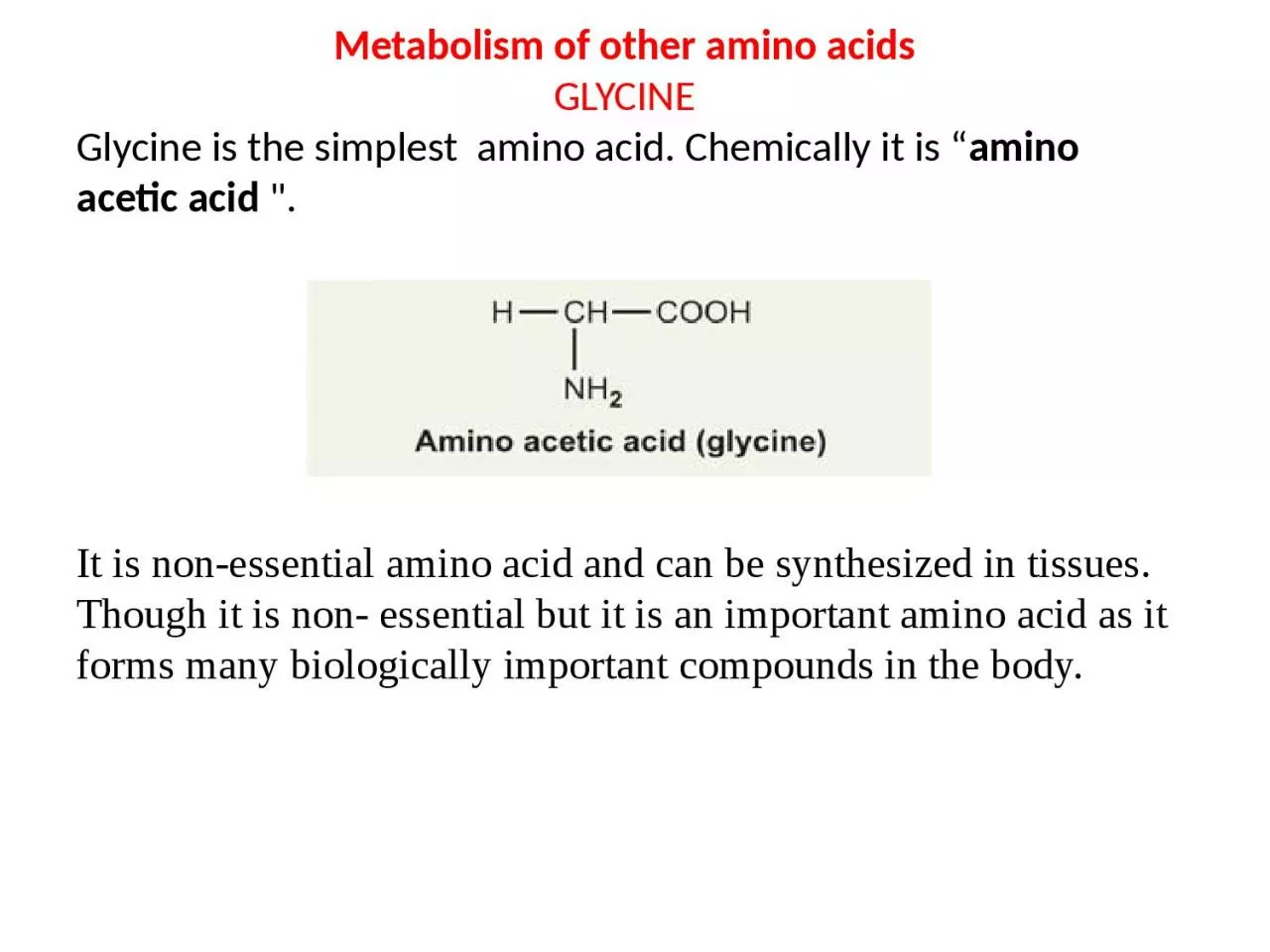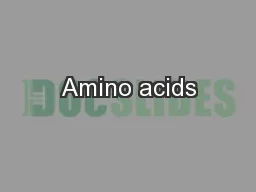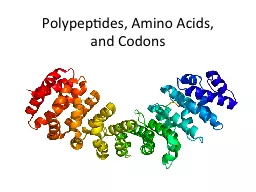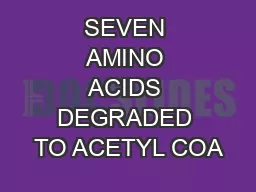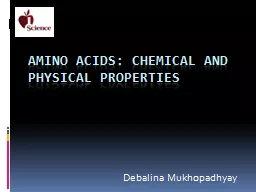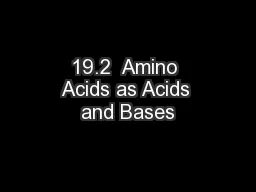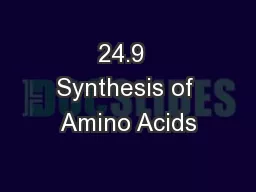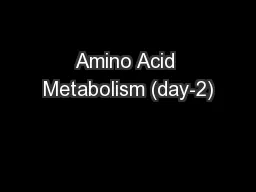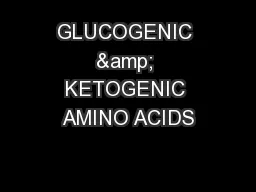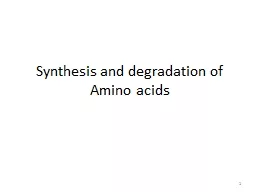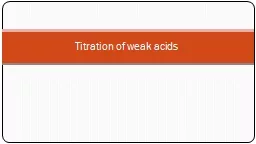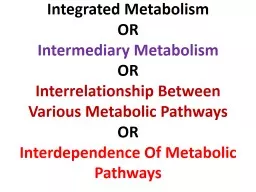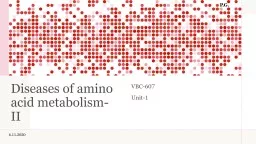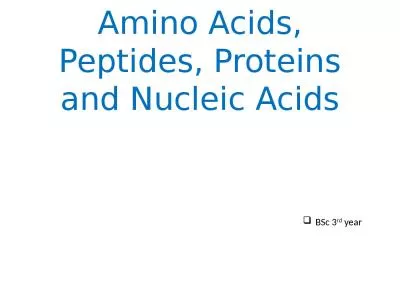PPT-Metabolism of other amino acids
Author : caroline | Published Date : 2022-06-28
GLYCINE Glycine is the simplest amino acid Chemically it is amino acetic acid It is nonessential amino acid and can be synthesized in tissues Though it is
Presentation Embed Code
Download Presentation
Download Presentation The PPT/PDF document "Metabolism of other amino acids" is the property of its rightful owner. Permission is granted to download and print the materials on this website for personal, non-commercial use only, and to display it on your personal computer provided you do not modify the materials and that you retain all copyright notices contained in the materials. By downloading content from our website, you accept the terms of this agreement.
Metabolism of other amino acids: Transcript
GLYCINE Glycine is the simplest amino acid Chemically it is amino acetic acid It is nonessential amino acid and can be synthesized in tissues Though it is non essential but it is an important amino acid as it forms many biologically important compounds in the body. What are amino acids?. Amino acids are the building blocks of proteins.. In the body, they exist as zwitterions.. Zwitterions can behave as both an acid or a base.. Today we will:. Study . the acid-base properties of amino acids, . (Foundation Block). Dr. Ahmed Mujamammi. Dr. . Sumbul. . Fatma. Learning outcomes. What are the amino acids?. General structure.. Classification of amino acids.. Optical properties.. Amino acid configuration.. Codons. Prefixes, Suffixes and Vocabulary. Poly. = many. Peptide bond . =bond between two amino acids.. Anti. = against, opposite. Dehydration. = loss of water. Polypeptide. = long assembled string of amino acids.. THE EXCRETION OF AMMONIUM IONS. A part of NH4+ that is formed in the degradation of amino acids is used for the biosynthesis of nitrogen compounds. In most of the land living vertebrates the excess NH4+ is converted in urea and in that form is excreted. In birds and reptiles it is converted into uric acid and in aquatic animals it is directly excreted as urea.. Debalina. . Mukhopadhyay. . . Containing carbon, hydrogen, nitrogen, oxygen. . Building blocks of protein. . Contain Amino group (NH2+) , carboxyl . group . (COO-) , Alkyl group (R ) / H . . alpha carbon contains the functional groups.. When an amino acid with positive and negative charges is overall neutral in charge, it is said to be at its . isoelectric point (. pI. ). .. . Ball-and-stick model of glycine at its . pI. of 6.0.. Plants and bacteria produce all of their amino acids using NH. 4. +. and NO. 3. –. .. Humans can synthesize 9 of the 20 amino acids found in their proteins.. Nonessential amino acids are synthesized in the body, while essential amino acids must be obtained from diet.. What to Know. What is the Metabolic Fate of Ammonium?. How is Escherichia coli Glutamine Synthetase regulated?. Understand general ways that organisms synthesize amino acids. Know the definition of essential versus nonessential amino acids. DR AMINA . BIOCHEMISTRY. All tissues have some capability for synthesis of:. The non-essential amino acids,. Amino acid remodeling, . and Conversion of non-amino acid carbon skeletons into amino acids and other derivatives that contain nitrogen. . 1. . Overview. The catabolism of the amino acids involves:. Removal of α-amino groups. . Breakdown of the resulting carbon skeletons.. The resulting compounds will be used to form seven intermediate products: . Amino acids are weak . polyprotic. acids . . Neutral amino acids are (. gly. , ala, threonine ) are treated as diprotic acids .. acidic amino acids (. glu. , asp,) are treated as . triprotic. acids .. Intermediary Metabolism. OR. Interrelationship Between Various Metabolic . Pathways. OR. Interdependence Of Metabolic Pathways. To Better Understand Metabolism Of Various Biomolecules . Metabolism of each . VBC-607. Unit-1. P.G.. 6.11.2020. MAPLE SYRUP URINE DISEASE. Also known as Branched chain ketonuria. Partial or complete deficiency of branched-chain . α . keto acid dehydrogenase (a multienzyme complex associated with inner membrane of mitochondrion). BSc 3. rd. year . AMINO ACIDS. C. lassification of amino acids . Classification according to nature of side chain. PREPARATION OF AMINO ACIDS. 1. Gabriel Phthalimide synthesis. 2. Strecker’s synthesis.
Download Document
Here is the link to download the presentation.
"Metabolism of other amino acids"The content belongs to its owner. You may download and print it for personal use, without modification, and keep all copyright notices. By downloading, you agree to these terms.
Related Documents

